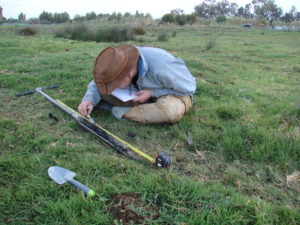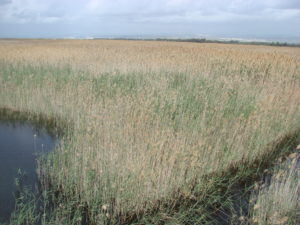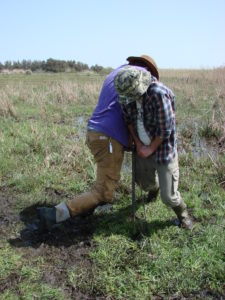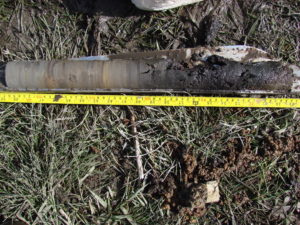
By Matthew Pound and Emma Hocking, senior lecturers in physical geography at Northumbria University and principal investigators in the CBRL-funded team project, Long-term landscape, environment and climate change studies; from past through to predictive models for future developments.
This interdisciplinary project sets out to examine potential environmental drivers for societal change in Bronze Age Cyprus through geographical and archaeological fieldwork.
What’s the debate?
Understanding past climate change is crucial to predicting the potential impact of future climate change. Of particular relevance in the context of societies reliant on agriculture are trends in rainfall and temperature. In the eastern Mediterranean, there is widespread archaeological evidence for the collapse of societies during two events in the Bronze Age (at around 4100 and 3200 years ago). However, the cause of these events is debated, with proposed causes including natural disasters, government instability, collapse of international trade, invasion, as well as climate change. One major problem in assessing the potential role of climate change during collapse events comes from the detail of Bronze Age climate records, and in some places a complete lack of climate records. As a better understanding of the impacts of past climate change on past civilizations will ultimately inform research surrounding the potential impacts of modern climate change on vulnerable Mediterranean sites, we aim to collect new detailed data on past climate change from new sites.
What are we doing to help solve this debate?
Our project is generating new detailed climate records for the Bronze Age from Cyprus; a semi-arid island facing threats to its biodiversity and agriculture from climate change. A combination of rising temperatures and reduced rainfall currently threatens both lowland vegetation and agriculture, as well as mountain ecosystems. This vulnerability to variable temperatures and rainfall likely existed throughout the last few thousand years and may be a contributing factor to any societal collapse on Cyprus in the Bronze Age. Cyprus also forms a key site for exploring the relationship between climate and societies due to a current lack of detailed climate records, as well as it’s relatively central location in the eastern Mediterranean.

How are we generating new Bronze Age climate records?
Unfortunately, weather station records are not available for the Bronze Age so we need to use natural archives (proxies) to infer climate. These archives are not evenly distributed and we have had to explore a number of ancient lakes and marshes. On Cyprus our best record comes from a marsh along the southern coast of the island. Today this site is a nature reserve, home to a diverse range of birds, cattle and mosquitos. For a period in March, it was also home to three scientists and a peat corer. The peat corer allowed us to drill down beneath the surface into the muddy archives of past climate. We took six cores from the Akrotiri marsh, managing to manually drill to a maximum depth of 2.25 metres.

We then use the properties of the mud we collected (colour, size of particles, organic content) and the tiny organisms (microfossils) that are preserved in it to provide a snapshot of what the climate would have been like at the time they were living. The microfossils we are using are pollen, spores and diatoms. Pollen and spores are the reproductive cells of plants and fungi, with plants in particular being sensitive to temperature and rainfall (try growing an avocado in northeast England!). Diatoms are single-celled algae which live in different environments depending on many factors including temperature, salinity and water level. The final important step in our analysis, is to determine how old the mud is that we have collected, which we are doing through radiocarbon dating. This allows us to relate any changes we see in microfossil populations to climate and link to archaeological evidence.

What’s next?
The mud we have collected shows broad changes in the environment that indicates it was getting wetter towards the present day. We are currently analysing the microfossils to develop our detailed Bronze Age climate record. We have taken small slices of mud every 2cm down the core, added chemicals to remove everything except the microfossils and then looked at the microfossils down a microscope to make them a thousand times bigger. The next stage will be to discuss our new climate record with archaeologists to see if there are any correlations between changes in climate and human populations.
Dr Matthew Pound is a senior lecturer in physical geography at Northumbria University. His research uses pollen and fungal spores to investigate environmental change in the present day, on archaeological time scales and in geological time. He received his NERC – British Geological Survey funded PhD in 2013 from the University of Leeds and was awarded a Geological Society of London President’s Award in the same year.
Dr Emma Hocking is a senior lecturer in physical geography at Northumbria University, with research interests in past environmental and sea level change on a range of timescales from events (e.g. earthquakes and tsunamis) to millennia. She currently works at a range of marsh, peatland and lake sites worldwide, including Cyprus, Chile and Antarctica.
The views expressed by our authors on the CBRL blog are not necessarily endorsed by CBRL, but are commended as contributing to public debate.












